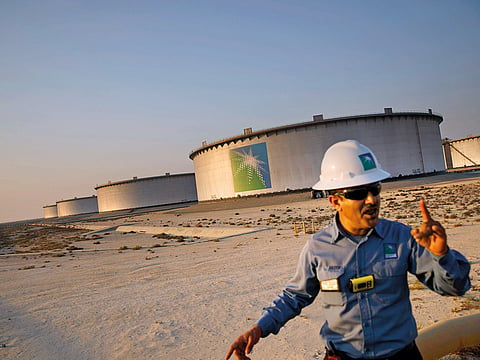Oil bulls flee with Saudis stirring deja vu of worst rout in decades
Brent for January settlement slid below $60 a barrel, capping worst week since 2016

Hedge funds haven’t been this pessimistic about global oil prices since Brent crude was spiralling into its worst rout in a generation almost three years ago.
Net-long wagers on the international benchmark fell 15 per cent in the week ending November 20, hitting their lowest level since oil crashed below $30 (Dh110) a barrel in January 2016, according to data released Friday by ICE Futures Europe.
Then as now, it’s Saudi Arabia and the United States that are tipping the balance, prompting money managers to bet against a price recovery. Under pressure from US President Donald Trump, the kingdom is pumping crude at a record pace even as volumes from American shale producers reach new heights.
“People are really reacting to a double whammy of both supplies and inventories going up at the same time that demand seems to be cooling down,” said Tamar Essner, an analyst at Nasdaq Inc. in New York. “Oil is getting hit from both sides.”
Net longs — the difference between bullish and bearish Brent wagers — fell to 182,569 futures and option contracts, the ICE Futures numbers showed. Long-only bets fell 8.6 per cent. Short positions climbed 6.6 per cent and have now more than tripled since late September.
The funds proved prescient. Brent for January settlement slid below $60 a barrel on Friday, capping its worst week since early 2016.
Data on hedge fund wagers for West Texas Intermediate crude, typically released on Fridays, won’t come until November 26 due to the US Thanksgiving holiday.
The Saudis have signalled they will throttle back on production in December. But unless the Organisation of the Petroleum Exporting Countries (Opec) and Russia can reach a new deal to constrain output in Vienna next month, analysts see the prospect of sustained oversupply in 2019, undoing the group’s success over the last two years to drain global inventories.
“It feels like the market’s going to really force their hand by trying to break $50,” Essner said.
Also indicating a shift in the market is the Brent futures curve. The closer the delivery date, the more buyers are asking for a discount, a sign of waning demand known as contango.
And in yet another sign of negative sentiment, oil options traders have turned more bearish than when prices plunged back in 2014.
The premiums they’re paying for bearish put options over bullish calls over the next 12 months has reached the largest in data compiled by Bloomberg since 2013. The skew, as it’s known, indicates demand for protection against a slump. The negative bias is far greater than during four years ago, when Saudi Arabia adopted a pump-at-will production policy, helping prices crash to $47 from $115 in a matter of months.
Sign up for the Daily Briefing
Get the latest news and updates straight to your inbox


